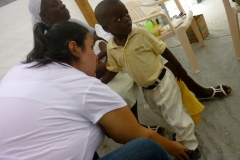
Hugs & Band-aids "

Nicole’s Story
Nicole graduated as the 2002 class president from Westminster Christian School, in Miami, Florida. She graduated Magna Cum Laude from UNIBE, Universidad Iberoamericana Medical School, in Santo Domingo, Republica Dominicana, in November 2010, as a fourth generation Mas family physician. She was a true passionate leader that was not afraid to cross boundaries and never saw race or color. All without a second thought or hesitation to help another in need. She was a noble leader that inspired her peers and professors. She was a huge part of the Haiti disaster relief efforts, organizing drives, making t-shirts and buttons to collect funds to take medicine, food and water.
She took them herself with donated trucks she acquired. She was not only there as a humanitarian but as an acting physician! She inspired everyone she came in contact with in one way or the other, positively and compassionately. She changed people for the better through her unconditional love and conviction to help others in need or through a struggle. She named her foundation prior to her passing and so we must continue her legacy of M.A.S., Medicina, Amor y Servicio. (Medicine, Love & Service).
Nicole’s Personal Statement
Nicole wrote this personal statement one month before she passed for her residency applications.
I grew up associating a white lab coat with my father, grandfather, uncle, and aunts. I thought that was what everyone wore to work: a white coat, a beeper, a cell phone, a pen, and pockets filled with papers and small books. My sweetest childhood memories include Hackensack Hospital parking lot picnics with my Dad during his residency in New Jersey and thinking the coolest accessory in the world was a stethoscope. I believed hugs and band-aids were the cures to all ailments. Life happens, and I chose to attend medical school and become a doctor myself.
January 12, 2010: As I sat on my apartment couch preparing my first pediatrics presentation, I suddenly felt dizzy. I couldn’t decipher if I was becoming ill or if I was nervous, but the walls looked like they were moving. When small trinkets began falling off my shelf, I realized I was not ill or nervous: it was an earthquake. The earthquake that hit Haiti made its presence known in Santo Domingo. Upon arriving at the hospital the following morning at 6 am. I quickly grasped the reality of the disaster. Buses of injured patients, truck beds filled with cadavers, and a panic-stricken crowd blocked the hospital entrance and hallways.
The supervising attending gathered all of us interns into a room, quickly briefed us on the severity of the situation, and handed out assignments. I was assigned to the Internal Medicine Emergency Room. After spending the day treating patients with a medley of pathologies, from mental distress to amputation-site infections, I was humbled by the blessing of being able to utilize what little medical knowledge I had acquired until that moment to help these individuals. The initial influx of disaster victims that occurred the night of the earthquake was quickly deterred by politics and the border was tightly guarded to prevent Haitians from entering the Dominican Republic, and vice versa. Feeling helpless, I dedicated myself to treating those who made it to our hospital, transformed my apartment into a donation site, and continued with my school obligations and studies.
The media reported as if Haiti was being showered with billions of dollars and there was water, food, shelter, and medical attention for all earthquake victims. Months passed, and political turmoil was pacified. As I arrived in Fond Parisien, Haiti, in June, I was once again struck by the reality of the disaster. There were rocks and sand and people—and not much else. For months, I traveled to Haiti every Sunday. When all you are equipped with is a stethoscope, a sphygmomanometer, a thermometer, and your five senses, your clinical skills and teamwork are re-tested and strengthened.
The encounters with these patients, the guidance of the supervising physicians, physical therapists, and medical support staff, and my dedication to learning reinforced what I already felt: I had made the right career and life choice. I love what I do, I live what I do, and I am dedicated to becoming the best Internal Medicine physician I can be. Many years passed since that last parking lot picnic, and now I am the one privileged enough to wear the white lab coat. I now know this coat is a sign of dedication to helping others, a serious responsibility, and a sacrifice. I now know a stethoscope is not a cute accessory, but a tool. And sadly, I now realize that hugs and band-aids cannot cure everything – but a hug never hurts.
Whether In a world-acclaimed hospital or under a straw hut on a plastic chair, my Job is to be prepared to treat each patient to the best of my ability with humility, dignity, integrity, compassion, and respect. From my time In Haiti to working with the medical team from Brigham and Women’s Hospital during Operation Walk Boston 2009–2011, each experience has allowed me to strengthen my knowledge and broaden my horizons. With the proper training at your institution, I hope to surpass my own expectations and build upon my foundation to better serve each patient I encounter.
-Nicole E. Mas, MD
















